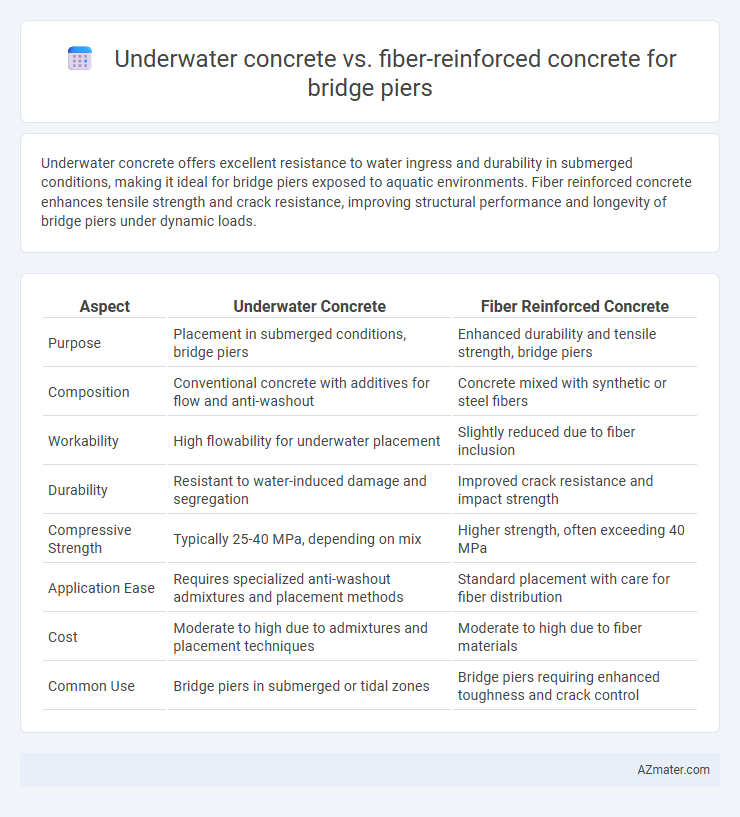Underwater concrete offers excellent resistance to water ingress and durability in submerged conditions, making it ideal for bridge piers exposed to aquatic environments. Fiber reinforced concrete enhances tensile strength and crack resistance, improving structural performance and longevity of bridge piers under dynamic loads.
Table of Comparison
| Aspect | Underwater Concrete | Fiber Reinforced Concrete |
|---|---|---|
| Purpose | Placement in submerged conditions, bridge piers | Enhanced durability and tensile strength, bridge piers |
| Composition | Conventional concrete with additives for flow and anti-washout | Concrete mixed with synthetic or steel fibers |
| Workability | High flowability for underwater placement | Slightly reduced due to fiber inclusion |
| Durability | Resistant to water-induced damage and segregation | Improved crack resistance and impact strength |
| Compressive Strength | Typically 25-40 MPa, depending on mix | Higher strength, often exceeding 40 MPa |
| Application Ease | Requires specialized anti-washout admixtures and placement methods | Standard placement with care for fiber distribution |
| Cost | Moderate to high due to admixtures and placement techniques | Moderate to high due to fiber materials |
| Common Use | Bridge piers in submerged or tidal zones | Bridge piers requiring enhanced toughness and crack control |
Introduction to Concrete Types for Bridge Piers
Underwater concrete for bridge piers is formulated to harden and gain strength while submerged, featuring anti-washout admixtures that ensure durability in aquatic environments. Fiber reinforced concrete incorporates steel, glass, or synthetic fibers to enhance tensile strength, crack resistance, and structural integrity under dynamic loading conditions. Selecting the appropriate concrete type depends on environmental exposure, load demands, and long-term performance requirements for bridge pier stability.
Key Properties of Underwater Concrete
Underwater concrete for bridge piers exhibits high fluidity and anti-washout characteristics, enabling effective placement in submerged environments without segregation or loss of strength. Its mix design includes special admixtures like anti-washout agents and superplasticizers to maintain cohesiveness and workability underwater. Compared to fiber reinforced concrete, underwater concrete prioritizes impermeability and resistance to water-induced erosion, crucial for structural durability in aquatic conditions.
Benefits and Applications of Fiber Reinforced Concrete
Fiber reinforced concrete (FRC) offers enhanced tensile strength, crack resistance, and durability compared to traditional underwater concrete, making it ideal for bridge piers exposed to dynamic loads and harsh environmental conditions. The integration of fibers improves impact resistance and reduces permeability, significantly extending the lifespan of bridge structures while minimizing maintenance requirements. FRC's versatility supports complex geometries and repair works in submerged conditions, optimizing structural resilience and performance in marine and riverine bridge applications.
Workability and Placement in Submerged Conditions
Underwater concrete exhibits superior workability due to its anti-washout admixtures, ensuring cohesive mixtures that resist segregation during placement in submerged conditions of bridge piers. Fiber reinforced concrete enhances structural toughness but demands careful mix design to maintain workability underwater, as fibers may impede flow and compaction. Effective underwater placement relies on anti-washout properties and controlled concrete rheology, with underwater concrete specifically engineered to retain integrity and bond under hydraulic pressures.
Durability and Longevity Comparison
Underwater concrete offers excellent resistance to chloride-induced corrosion and sulfate attack, making it highly durable in submerged bridge pier environments. Fiber reinforced concrete enhances tensile strength and crack control, reducing permeability and mitigating freeze-thaw damage, which significantly extends the lifespan of bridge piers exposed to dynamic water conditions. Durability studies indicate underwater concrete performs better in static aquatic exposure, whereas fiber reinforced concrete excels in resisting mechanical stresses and cyclic loading for long-term longevity.
Structural Performance Under Load
Underwater concrete for bridge piers provides excellent durability and resistance to water infiltration, maintaining structural integrity under cyclic loading and hydrostatic pressure. Fiber reinforced concrete enhances tensile strength, crack resistance, and toughness, improving load-bearing capacity and energy absorption during dynamic loads such as traffic and seismic activity. Combining both materials can optimize pier performance by leveraging underwater concrete's impermeability and fiber reinforcement's increased mechanical resilience.
Resistance to Corrosion and Chemical Attack
Underwater concrete for bridge piers offers superior resistance to corrosion and chemical attack due to its dense matrix and specialized chemical admixtures that prevent water infiltration and chloride ingress. Fiber reinforced concrete enhances durability by distributing tensile stresses and reducing crack propagation, which limits pathways for corrosive agents but may still be vulnerable if not properly sealed. Combining underwater concrete's impermeability with fibers' crack resistance provides an optimized solution against corrosion and chemical degradation in marine environments.
Cost Analysis: Installation and Maintenance
Underwater concrete for bridge piers generally incurs higher installation costs due to specialized equipment and techniques required for mixing, placing, and curing in submerged conditions, increasing labor and time expenses. Fiber reinforced concrete (FRC) offers potential cost savings in maintenance by enhancing durability and crack resistance, reducing the frequency and extent of repairs over the bridge pier's lifecycle. While initial material costs for FRC may be higher than conventional underwater concrete, long-term savings in maintenance and improved structural performance often offset these expenses, making FRC a cost-effective solution for bridge pier construction.
Sustainability and Environmental Considerations
Underwater concrete for bridge piers offers enhanced durability and reduced chemical leaching, minimizing environmental contamination in aquatic ecosystems. Fiber reinforced concrete improves crack resistance and extends structural lifespan, lowering the frequency of repairs and associated resource consumption. Both materials contribute to sustainability by optimizing longevity, but underwater concrete specifically reduces environmental impact during construction through its tailored mix design for submerged conditions.
Recommendations for Choosing the Right Concrete Type
Choosing between underwater concrete and fiber reinforced concrete for bridge piers depends on site-specific conditions and structural requirements. Underwater concrete is ideal for submerged foundations, offering excellent workability and resistance to washout during placement under water, while fiber reinforced concrete enhances tensile strength and crack resistance, improving durability in exposed or high-stress environments. For optimal performance, use underwater concrete in submerged pier foundations and integrate fiber reinforced concrete in above-water sections subject to dynamic loads and environmental exposure.

Infographic: Underwater concrete vs Fiber reinforced concrete for Bridge pier
 azmater.com
azmater.com